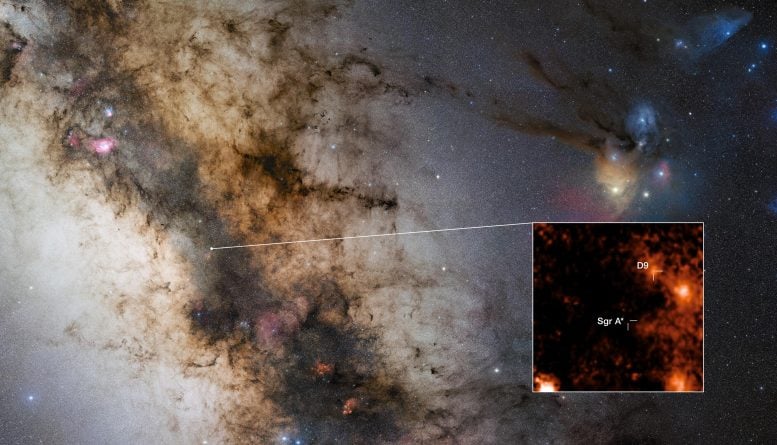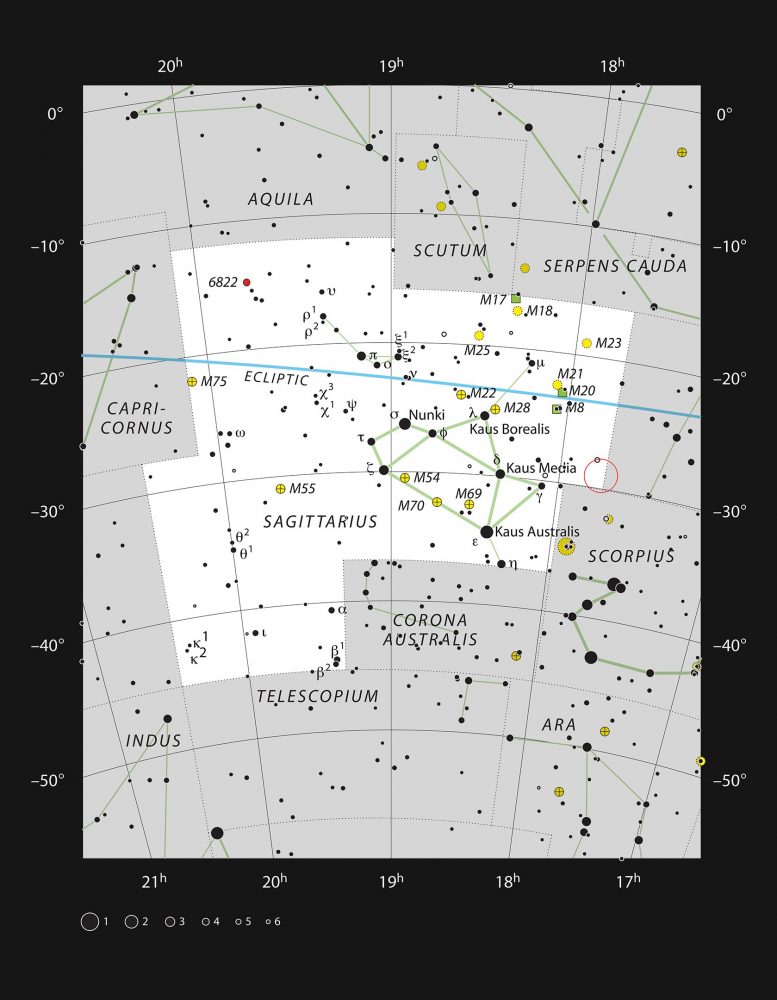
By European Southern Observatory (ESO) December 26, 2024
Collected at: https://scitechdaily.com/first-ever-binary-stars-spotted-near-the-milky-ways-supermassive-black-hole/
Astronomers have made a groundbreaking discovery: a binary star orbiting perilously close to the supermassive black hole at the center of our galaxy, Sagittarius A*.
This stellar pair defies expectations, thriving temporarily in an environment of immense gravity. Dubbed D9, the stars offer a rare glimpse into how systems can survive and even form in such extreme conditions.
Discovery of Binary Stars Near Sagittarius A*
A team of international researchers has discovered a binary star system orbiting near Sagittarius A*, the supermassive black hole at the center of our galaxy. This marks the first time a stellar pair has been found in such close proximity to a supermassive black hole. The discovery, made using data from the European Southern Observatory’s Very Large Telescope (ESO’s VLT), sheds light on how stars can endure in regions of extreme gravitational forces. It also opens new possibilities for detecting planets near Sagittarius A*.
“Black holes are not as destructive as we thought,” explains Florian Peißker, a researcher at the University of Cologne, Germany, and lead author of the study published on December 17 in Nature Communications. Binary stars — pairs of stars that orbit each other — are common throughout the universe. However, until now, none had been observed near a supermassive black hole, where intense gravitational forces typically destabilize such systems.
A Cosmic Race Against Time
This new discovery shows that some binaries can briefly thrive, even under destructive conditions. D9, as the newly discovered binary star is called, was detected just in time: it is estimated to be only 2.7 million years old, and the strong gravitational force of the nearby black hole will probably cause it to merge into a single star within just one million years, a very narrow timespan for such a young system.
“This provides only a brief window on cosmic timescales to observe such a binary system — and we succeeded!” explains co-author Emma Bordier, a researcher also at the University of Cologne and a former student at ESO.

Challenging Assumptions About Star Formation
For many years, scientists also thought that the extreme environment near a supermassive black hole prevented new stars from forming there. Several young stars found in close proximity to Sagittarius A* have disproved this assumption. The discovery of the young binary star now shows that even stellar pairs have the potential to form in these harsh conditions. “The D9 system shows clear signs of the presence of gas and dust around the stars, which suggests that it could be a very young stellar system that must have formed in the vicinity of the supermassive black hole,” explains co-author Michal Zajaček, a researcher at Masaryk University, Czechia, and the University of Cologne.
The Mysterious S Cluster and G Objects
The newly discovered binary was found in a dense cluster of stars and other objects orbiting Sagittarius A*, called the S cluster. Most enigmatic in this cluster are the G objects, which behave like stars but look like clouds of gas and dust.
It was during their observations of these mysterious objects that the team found a surprising pattern in D9. The data obtained with the VLT’s ERIS instrument, combined with archival data from the SINFONI instrument, revealed recurring variations in the velocity of the star, indicating D9 was actually two stars orbiting each other. “I thought that my analysis was wrong,” Peißker says, “but the spectroscopic pattern covered about 15 years, and it was clear this detection is indeed the first binary observed in the S cluster.”
Unveiling the Nature of Galactic Objects
The results shed new light on what the mysterious G objects could be. The team proposes that they might actually be a combination of binary stars that have not yet merged and the leftover material from already merged stars.
The precise nature of many of the objects orbiting Sagittarius A*, as well as how they could have formed so close to the supermassive black hole, remain a mystery. But soon, the GRAVITY+ upgrade to the VLT Interferometer and the METIS instrument on ESO’s Extremely Large Telescope (ELT), under construction in Chile, could change this. Both facilities will allow the team to carry out even more detailed observations of the Galactic center, revealing the nature of known objects and undoubtedly uncovering more binary stars and young systems. “Our discovery lets us speculate about the presence of planets, since these are often formed around young stars. It seems plausible that the detection of planets in the Galactic center is just a matter of time,” concludes Peißker.

Reference: “A binary system in the S cluster close to the supermassive black hole Sagittarius A*” by Florian Peißker, Michal Zajaček, Lucas Labadie, Emma Bordier, Andreas Eckart, Maria Melamed and Vladimír Karas, 17 December 2024, Nature Communications.
DOI: 10.1038/s41467-024-54748-3

The team is composed of F. Peißker (Institute of Physics I, University of Cologne, Germany [University of Cologne]), M. Zajaček (Department of Theoretical Physics and Astrophysics, Masaryk University, Brno, Czechia; University of Cologne), L. Labadie (University of Cologne), E. Bordier (University of Cologne), A. Eckart (University of Cologne; Max Planck Institute for Radio Astronomy, Bonn, Germany), M. Melamed (University of Cologne), and V. Karas (Astronomical Institute, Czech Academy of Sciences, Prague, Czechia).
The European Southern Observatory (ESO) enables scientists worldwide to discover the secrets of the Universe for the benefit of all. We design, build and operate world-class observatories on the ground — which astronomers use to tackle exciting questions and spread the fascination of astronomy — and promote international collaboration for astronomy. Established as an intergovernmental organisation in 1962, today ESO is supported by 16 Member States (Austria, Belgium, Czechia, Denmark, France, Finland, Germany, Ireland, Italy, the Netherlands, Poland, Portugal, Spain, Sweden, Switzerland and the United Kingdom), along with the host state of Chile and with Australia as a Strategic Partner. ESO’s headquarters and its visitor centre and planetarium, the ESO Supernova, are located close to Munich in Germany, while the Chilean Atacama Desert, a marvellous place with unique conditions to observe the sky, hosts our telescopes. ESO operates three observing sites: La Silla, Paranal and Chajnantor. At Paranal, ESO operates the Very Large Telescope and its Very Large Telescope Interferometer, as well as survey telescopes such as VISTA. Also at Paranal ESO will host and operate the Cherenkov Telescope Array South, the world’s largest and most sensitive gamma-ray observatory. Together with international partners, ESO operates ALMA on Chajnantor, a facility that observes the skies in the millimetre and submillimetre range. At Cerro Armazones, near Paranal, we are building “the world’s biggest eye on the sky” — ESO’s Extremely Large Telescope. From our offices in Santiago, Chile we support our operations in the country and engage with Chilean partners and society.

Leave a Reply